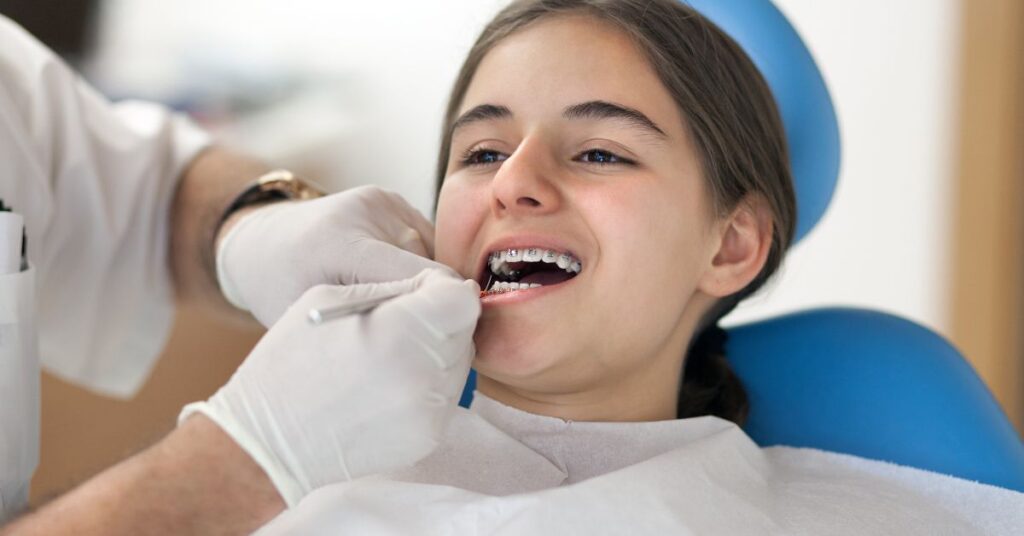Dental Braces
- Home
- Dental Braces
Dental Braces
Dental braces are a popular orthodontic treatment option that has helped millions of people around the world achieve a straighter and healthier smile. They consist of metal or ceramic brackets that are attached to the teeth and connected by wires and elastic bands. Over time, the braces apply gentle pressure to the teeth, gradually moving them into their correct positions. In this article, we will cover everything you need to know about dental braces, including how they are made, who they are for, their cost, the procedure, cleaning, and tuning.

How are Dental Braces Made?
Dental braces consist of several components, including brackets, archwires, and elastic bands. The brackets are typically made of metal or ceramic and are attached to the teeth using a special adhesive. The archwires are made of a thin, flexible metal and are threaded through the brackets. Elastic bands are used to connect the archwires to the brackets.
Brackets are usually made of metal, but they can also be made of ceramic or plastic. Metal brackets are the most common because they are the strongest and most durable. Ceramic and plastic brackets are less noticeable, but they can be more fragile and may require more maintenance.
Archwires are made of a special type of metal alloy that is designed to be flexible and resilient. The archwire is threaded through the brackets, and then tightened to apply pressure to the teeth. As the teeth move into their correct positions, the archwire is adjusted to maintain the right amount of pressure.
Elastic bands are used to connect the archwire to the brackets. They come in a variety of colors and can be customized to match your personal style.
Who are Dental Braces for?
Dental braces are suitable for anyone who wants to improve the alignment of their teeth. They can be used to correct a wide range of dental issues, including crooked teeth, overcrowding, gaps, and bite problems. They are most commonly used for children and teenagers, but adults can also benefit from braces.
Orthodontic treatment can be started as early as age 7, but the optimal time to start braces varies depending on the individual. In general, braces are most effective when the patient has a mix of baby teeth and permanent teeth. This is usually around the age of 12. However, adults can also benefit from braces, and there is no age limit for treatment.
What Do Dental Braces Cost
The cost of dental braces varies depending on several factors, including the type of braces, the length of treatment, and your location. In the United States, the average cost of braces is between $3,000 and $7,000. However, the cost can be higher or lower depending on where you live and the type of braces you choose.
Metal braces are usually the least expensive option, with an average cost of $3,000 to $5,500. Ceramic braces are more expensive, with an average cost of $4,000 to $8,000. Lingual braces, which are attached to the back of the teeth, are the most expensive option, with an average cost of $8,000 to $10,000.
It is important to note that many dental insurance plans cover the cost of braces, at least in part. Some plans may cover up to 50% of the cost of treatment. If you have dental insurance, be sure to check with your provider to see what is covered.
Dental Braces Procedures
The dental braces procedure usually takes between 1 and 2 hours. The first step is to clean and dry the teeth. Next, the brackets are attached to the teeth using a special adhesive. Once the brackets are in place, the arch-wire is threaded through them and secured with elastic bands.
After the braces are installed, the patient may experience some discomfort and soreness for a few days as the teeth begin to shift. It is important to follow the orthodontist’s instructions for taking care of the braces during this time, which may include eating soft foods and avoiding hard, crunchy, or sticky foods that can damage the braces.
During the course of treatment, the orthodontist will periodically adjust the archwire to maintain the correct amount of pressure on the teeth. This may cause some discomfort, but it is a necessary part of the process.
Most patients wear braces for 1-3 years, depending on the severity of their dental issues. After the braces are removed, the patient may need to wear a retainer to keep the teeth from shifting back to their original positions.
Tuning Dental Braces
Tuning, also known as adjusting or tightening, is an important part of orthodontic treatment. As the teeth move into their correct positions, the archwire needs to be adjusted to maintain the right amount of pressure.
During a tuning appointment, the orthodontist will remove the elastic bands that connect the archwire to the brackets. They will then adjust the archwire and reattach the elastic bands. This process may cause some discomfort or soreness, but it is a necessary part of the treatment.
Tuning appointments usually take place every 4-6 weeks, depending on the patient’s individual needs. It is important to keep all scheduled appointments to ensure the best possible results and to avoid prolonging the treatment.
Dental braces are a popular and effective orthodontic treatment option that can help improve the alignment of the teeth and create a healthier, more beautiful smile.
Dental braces are a popular and effective orthodontic treatment option that can help improve the alignment of the teeth and create a healthier, more beautiful smile. The braces consist of several components, including brackets, archwires, and elastic bands, and the treatment usually lasts between 1 and 3 years.
Braces are suitable for anyone who wants to improve the alignment of their teeth, and they can be used to correct a wide range of dental issues. The cost of braces varies depending on several factors, including the type of braces and the length of treatment, but many dental insurance plans cover the cost at least in part.
Proper cleaning and maintenance of braces is important to ensure the best possible results and to prevent tooth decay and gum disease. Regular tuning appointments are also important to adjust the archwire and maintain the correct amount of pressure on the teeth.
If you are considering braces, speak with your orthodontist or dentist to determine if they are right
5 Different types of braces available today:
Find The Best Orthodontist Office
For Dental Braces Today
Find And Review Local Orthodontist Offices
On The Dental Office Network!

